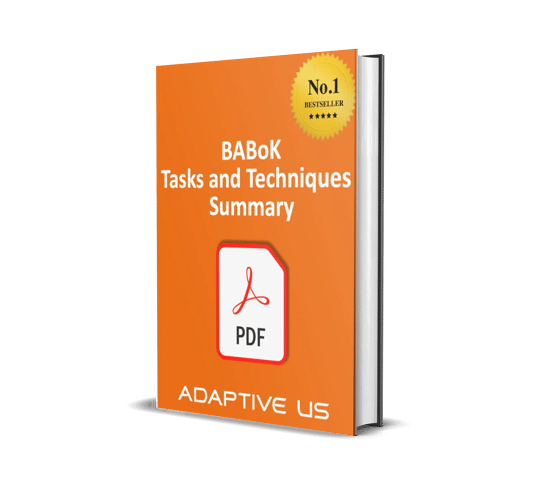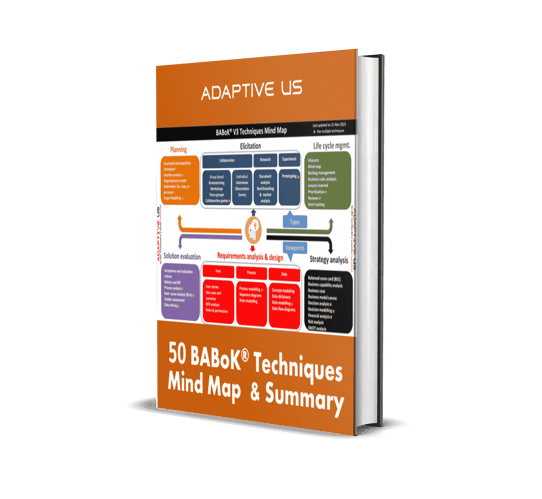How to Attempt Knowledge Area Questions in the CBAP Exam
CBAP (Certified Business Analysis Professional) is a highly coveted certification for senior business analysts. The CBAP certification exam focuses on all six knowledge areas in BABoK (The Business Analysis Body of Knowledge). The BABoK is a guide to Business Analysis. It describes a set of knowledge areas that guide a business analyst in performing business analysis activities during the project or product lifecycle. Knowledge domains define what business analysts need to understand and what tasks they should perform. They do not define project phases, and their activities are not intended to be carried out linearly. Tasks from one or more knowledge areas can be performed in any order (e.g., sequentially, concurrently, or iteratively), provided the required inputs for each task are available.
The BABoK® Guide defines six areas of knowledge. Suppose you plan to take the Entry Certificate in Business Analysis (ECBA), Certification of Competency in Business Analysis (CCBA), or Certified Business Analysis Professional (CBAP) exams. In that case, you need to know each knowledge area in-depth and their detailed tasks, items, inputs, and outputs. If you are interested in applying these areas of knowledge in your work environment to become an effective business analyst, you must master these tasks and skills.
The six knowledge areas are listed here:
- Business Analysis Planning and Monitoring
- Elicitation and Collaboration
- Requirements Life Cycle Management
- Strategy Analysis
- Requirements Analysis and Design Definition
- Solution Evaluation
Let us get more in-depth information about these knowledge areas and their tasks
1. Business Analysis Planning and Monitoring
This knowledge area mainly tackles how a business analyst plans to approach the business analysis effort. The approach consists of processes, templates, and activities used to perform business analysis in a specific context. The planning and monitoring activities occur throughout the project life cycle while the tasks organize and coordinate the performance of all other BA tasks. The results from this knowledge area guide the tasks in the remaining five areas and determine the performance metrics used to evaluate all business analysis work.
What is Business Analysis Planning and Monitoring about?
- Plan the BA approach for the project
- Determine methods to engage stakeholders, including stakeholder identification, analysis, and categorization
- Define the business analysis governance activities for decision making
- Address business analysis information management needs
- Plan the requirements development and management process
- Manage and report on the business analysis effort
The detailed task description of each task and its role in the BA Planning and Monitoring efforts:
Plan Business Analysis Approach
This task generates a business analysis approach. The BA approach defines how the business analysis for the initiative is performed. The procedure depends on many factors. One of them is the planning approach you choose: when you work according to the waterfall development lifecycle, you have a high level of formality and clear phasing in the activities. On the other hand, when you work with an iterative development lifecycle, you have less formality and continuous analysis activities. The next step is to derive the required deliverables and tasks needed to complete them, including the timeline.
Plan Stakeholder Engagement Approach
This task creates a stakeholder engagement approach. We know stakeholders can make or break the initiative. Therefore, understanding your stakeholder's needs and expectations is critical to the success of any initiative. This task deals with the identification and analysis of stakeholders to develop the best possible communication and engagement strategies.
Plan Governance Approach
This task creates a governance approach for the business initiative. The Governance Approach defines how decisions are to be made when it comes to business analysis work, e.g., B. Prioritization or approvals. Here, you can consider defining
- who approves the deliverables,
- who makes the final decisions in conflicting situations,
- what the change management process looks like,
- who makes decisions about changes in the different phases of this process.
Having these aspects clarified and documented saves a lot of time later in the initiative.
Plan Business Analysis Information Management
During the business analysis work, you receive a lot of input: documents, interview notes, process descriptions, etc. You need to have a plan to efficiently deal with all this business analysis information, what to keep, where and when it is stored, and who can access it. You also consider requirements reuse: i.e., you can identify requirements that you can reuse or decide to create requirements that others can reuse.
For requirements management purposes, you need to decide which requirement attributes you want to use. You also decide how to trace requirements back to other business analysis information, such as test cases, models, or code.
Identify Business Analysis Performance Improvements
This is a special task in business analysis planning and monitoring. It's not about preparing for the business analysis work. Rather, it's about making sure the work gets done effectively and efficiently. This knowledge area has an additional input: performance objectives. These objectives are used to define the metrics and measures for the BA process. Improvements are defined and implemented if a discrepancy between expected and measured performance is identified. Knowing what is expected from the process helps us achieve the expected level.
2. Strategy Analysis
Strategy analysis focuses on how a BA identifies the business needs that drive a project by conducting problem definition and analysis. The responsibilities of a BA include defining and refining these strategic or tactical requirements and a viable solution scope that the business can implement. Strategy Analysis also includes developing a business case or feasibility study for a proposed project. The tasks in this knowledge area occur before or at the beginning of the project life cycle.
The BAs task list for strategy analysis includes translating business strategy into proposed new business or enterprise solutions by doing the following:
- Define and understand business opportunities or problems
- Assess capability gaps in the business/organization by analyzing the current and future states
- Assess risks relative to the proposed solution
- Define the change strategy for the initiative
- Determine the most feasible business solution approach
Detailed task descriptions of each task and its role in strategy analysis.
Analyze current state
The focus of this task is to understand why a change is needed and to create a set of business requirements and the current state description. While executing this step, it is imperative you take a critical look at the business needs to understand why the organization must work on it. You will evaluate organizational structures and cultures to identify barriers that may impact the implementation of change. The business capabilities and processes, as well as the infrastructure, are analyzed to identify areas for improvement. The findings from this analysis contribute to the determination of the current situation.
Define future state
BABoK describes the future state as a set of conditions required to meet business needs and define the success of the initiative. The task requires BAs to identify goals and objectives for the future state to be achieved. The goals help in measuring success. BAs document constraints that limit the solution space and scope of the solution. The solution scope includes a description of aspects related to organizational structures, skills and technology, processes, infrastructure, external influences, policies, and internal assets that require change.
Assess risks
As a BA, when you examine the current situation and define the future state, you will also discover risks, i.e., events that can occur and, if they do occur, how much they will adversely affect change. Because their negative impact can reduce the value of the solution, BAs check the organization's willingness to accept the risks, as this influences the acceptance of the change strategy. The final step is to recommend a risk strategy (accept the risk, transfer the risk, eliminate or address the risk by identifying mitigation actions) through effective stakeholder collaboration.
Define change strategy
By knowing the current state, the future state, and the risks associated with it allows BAs can determine the solution approach. You have to define the breadth and depth of a solution to adequately explain it to stakeholders.
Next, perform a gap analysis, which involves:
- defining advantages,
- disadvantages,
- identifying alternative solutions and risks for each option,
- developing the financial analysis to determine potential value,
- verifying the organization's readiness to accept a particular solution.
- Finally, think about strategies to deploy potential solutions that map requirements to phases and releases.

3. Requirements Life Cycle Management
Requirements Life Cycle Management defines how BAs approach the management and maintenance of requirements. Conflicts and issues related to requirements and tasks, and techniques for change management, are described in this knowledge area.
To perform requirement management tasks as part of requirements development work, BAs must do the following:
- Manage requirements traceability
- Maintain requirements for accuracy and reuse
- Address requirements prioritization
- Determine how requirements should change
- Facilitate requirements approval
Trace Requirements
The focus of this task is to establish relationships between requirements and designs at different levels. Requirements traceability ensures that requirements and designs are coordinated. You decide which traces are relevant to your initiative and what added value they bring. Setting up traceability and maintenance is expensive work that needs to be justified. In the case of heavily regulated environments (e.g., healthcare), a regulator may enforce traceability.
Maintain Requirements
The requirements and designs must remain accurate and consistent throughout their lifecycle. This means it’s a BAs responsibility to maintain requirements, designs, and their attributes in a way that reflects the current status of the initiative. You should also evaluate whether requirements can be reused (to speed up the requirements development process) or perhaps strive to create a set of reusable requirements for other initiatives.
Prioritize Requirements
This task focuses on ranking the requirements according to their relative importance. It requires BAs to know the relevant stakeholders who should participate in the prioritization process. Priority is relative importance, so as a BA, you need to know what factors constitute a priority: think of cost, risk, benefit, and dependency. Key stakeholders also need to understand and agree with these factors. In addition, you are responsible for managing conflicts between the stakeholders involved and working towards a solution and agreement between the parties.
Assess Requirements Changes
This task is about evaluating the impact of a proposed change. You evaluate the change against the overall project goals. Among other things, you clarify how this change will affect the value of the company; How does time affect it? How does this affect the budget? Depending on your business analysis approach, you may opt for more or less formal change management. Nonetheless, these questions need to be answered, and this task ensures that the implications of the changes are known and well-understood by stakeholders.
Approve Requirements
As you perform this task, you obtain agreement and approvals on requirements and designs. To perform this task, you must understand the roles of stakeholders and their level of authority. You will reach a consensus on approvals and manage conflicts that may arise due to differences between stakeholders. Finally, you also communicate the approvals to the remaining stakeholders who did not take part in the approval process.
4. Elicitation and Collaboration
Elicitation and Collaboration define how business analysts work with stakeholders in order to elicit requirements and understand stakeholder needs and concerns. This knowledge area also deals with ongoing collaboration and communication during all business analysis activities.
A BAs task list for this knowledge area consists of the following responsibilities:
- Prepare for elicitation activities
- Meet with stakeholders to conduct the elicitation activity
- Confirm, document, and record the elicitation results
- Communicate and confirm elicitation results with key stakeholders
Prepare for Elicitation
The main focus of this task is understanding the scope of elicitation and defining which stakeholders should participate and what activities they should participate in. During preparation, the elicitation techniques are selected based on cost and time constraints, the culture of the organization, and the sources of business analysis information. With the knowledge of stakeholders and techniques, the follow-up activities take place: ensuring supporting materials are available, setting up the logistics, and preparing the stakeholders for elicitation to create the Elicitation Activity Plan.
Conduct Elicitation
In this task, the main work, i.e., Elicitation, is done. IIBA recognizes three types of elicitation: collaborative, research and experimentation. Each elicitation event provides elicitation results. Importantly, the sponsor can help here by giving BAs authorization and helping them engage stakeholders.
Confirm Elicitation Results
After each elicitation event, BAs document the elicitation result received and verify its accuracy and consistency with all previously documented information. This is the main objective of the Confirm Elicitation Results task. BAs compare the information with the source and with information already collected. So that in case they spot errors or omissions, it is possible to fix them early.
Communicate Business Analysis Information
This task is about gaining a common understanding of business analysis information. Business analysts organize the verified information into packages based on the target audience, their information needs, communication style, and level of formality. They must decide how to share these packages: formally or informally. You also decide on a form of communication: reach out to a group or an individual, use email to spread information, organize a meeting, etc.
Manage Stakeholder Collaboration
This task strives to encourage stakeholders to work together. It has an aspect of reaching an agreement on the obligations of the stakeholders involved. How do they spend the allotted time? Do they commit to dedicating time to the initiative? The second aspect of managing engagement with stakeholders is to review their levels of performance and involvement. Both these aspects allow us to find ways to better engage stakeholders and ensure their optimal performance in business analysis activities.
5. Requirements Analysis and Design Definition
Requirements Analysis and Draft Definition describes how the business analyst progressively defines, refines, prioritizes, and organizes requirements. Essentially, the business analyst takes the information gathered and makes sense of it to derive the actual requirements for the project. The focus in this knowledge area is on the graphic modeling of the requirements and the resulting designs, as well as their documentation. In performing these tasks, BAs must ensure the feasibility of the requirements while defining, describing, and refining the characteristics of an acceptable solution.
A BAs task list for this knowledge area consists of the following responsibilities:
- Specify and model requirements and designs
- Verify requirements and designs
- Validate requirements and designs
- Define the architecture and structure of the requirements
- Define solution options
- Analyze value and recommend a solution
Specify and model requirements
The main focus of this task is on the analysis and refinement of elicited requirements. It's also about representing requirements and the best way to document them: as a table, as text, as a diagram, or perhaps a combination of different formats. This is determined based on stakeholder knowledge, organizational standards, and sometimes by regulations.
Verify requirements
This task ensures that the requirements and designs created meet quality standards while also checking whether the requirements and designs are usable for those who will work with them. The tasks often include notation checks, checks against company standards, and cross-checks with other information.
Validate requirements
Requirements validation ensures that requirements and designs are consistent with the high-level business requirements and check whether the requirements enable the organization to achieve the future state as defined in the knowledge area Strategy Analysis.
Define requirements architecture
This task is about organizing the requirements and designs in a way that is relevant and informative for the target group(s). The stakeholders have different information needs, and these information needs are called ‘views’ in BABoK. As you work on requirements, try to anticipate what views will be required and then move on to define how the requirements and their relationships will be represented. Take the organized information and create a requirements architecture to support them.
Define design options
The main goal of this task is to define the solution approach. You decide whether to build or buy a solution or combine these two approaches. You identify opportunities for improvement and define design options with their key performance indicators. To examine how the design option addresses the problem, map the requirement to the design option.
Define potential value and recommend a solution
You are expected to recommend a design option for further development. To do this, you conduct activities that compare design options with each other so that you can objectively select the option that will bring the greatest benefit to the organization in the given situation. It is necessary to document the costs and benefits of each option to determine the potential value it delivers. When making a recommendation, also consider aspects such as available resources, previously identified limitations, and dependencies.
6. Solution Evaluation
This knowledge area focuses on evaluating and validating proposed, in-process, and implemented solutions before, during, and after the project life cycle. A business analyst's attention is focused on the value that the solution delivers to the business, including the limitations that may affect value. While many tasks in this knowledge area take place later in the project life cycle, some solution-oriented activities can take place quite early.
A BAs task list for this knowledge area consists of the following responsibilities:
- Define solution performance measures
- Collect and analyze solution performance data
- Assess solution limitations
- Assess enterprise limitations
- Recommend actions to increase solution value
Measure solution performance
This task is devoted to defining the performance metrics for the solution to verify that the solution is delivering the value expected by the organization. It also includes elements for taking the power measurements and eliciting the raw power data.
Analyze solution performance
In this task, the BA analyzes and interprets the raw data from the previous task. This helps in understanding whether the solution is delivering the value expected by stakeholders. This means that a BA collaborates with stakeholders to determine what value the solution seeks to realize and validates that the solution fulfills that objective.
Assess solution limitation
When a discrepancy in behavior is identified, the solution is to perform root cause analysis to find the causes of poor performance. This task focuses on finding root causes that are internal to the solution, like bugs.
Assess enterprise limitations
This task addresses the external causes of solution inefficiency. These external causes can be related to stakeholders working with the solution, business processes that the solution supports, or organizational structures in which the solution is used. BABoK advises taking a broad perspective when looking for possible limitations. Just like the previous task, external constraints are documented, categorized, and analyzed to enable corrective action.
Recommend actions to increase solution value
The final task in the Solution Evaluation knowledge area is about taking corrective action. This includes defining the action plan to resolve the poor performance of the solution. As a result, BAs can realize performance improvement; hence, the value that the solution delivers to the business increases.
Business Analysts need this knowledge to prepare for and pass the certification exams successfully. It also helps you to be an effective business analysis practitioner in your organization.
How to Remember 50 BABoK Techniques
How to Prepare for CBAP Certification Exam
Timeline Perspective of Business Analysis Tasks
Enterprise Analysis vs. Strategy Analysis

For more information, please visit our page
CBAP Certification
Free CBAP Training
You May Also Like
These Related Stories

CBAP Training in Bangalore | Success Guaranteed | 900+ CBAPs

Top 10 CBAP Certification Myths IT Professionals Have



No Comments Yet
Let us know what you think